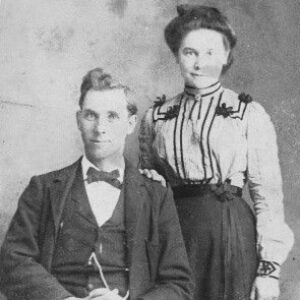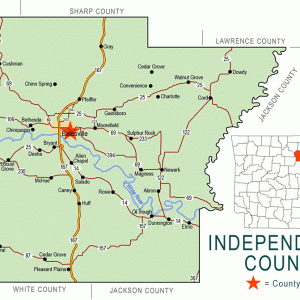calsfoundation@cals.org
Gainsboro (Independence County)
Gainsboro is located between Pfeiffer (Independence County) and Moorefield (Independence County), about seven miles east-northeast of Batesville, the county seat. The community, which never had a post office, grew out of Sharp’s Cross Roads, located about one and a half miles north-northwest of Gainsboro; Sharp’s Cross Roads was earlier called Rust’s. The historic community of Gainsboro is located on Watson Road just south of its junction with Highway 25 (White Drive).
Gainsboro likely received its name from the Gaines family, which was farming in the area before the Civil War. A short-lived post office was at Rust’s (1856–1859), with John David McKinney postmaster, but it was replaced by the Sharp’s Cross Roads post office established in 1859, with Samuel Y. Sharp appointed first postmaster—hence the name.
Prominent among the early settlers of Gainsboro was the Huddleston family from McNairy County, Tennessee. Brothers William Pryor (W. P.) Huddleston Jr., James Fleming Huddleston, and Wiley Bibb Huddleston moved with their parents and siblings to Ruddell (Independence County) in 1849 and, by the 1860 census, were living in Gainsboro Township. Both Wiley and W. P. Huddleston ran the store at Sharp’s Cross Roads and served as postmaster from time to time. Aquilla Wilson Mack settled on 280 acres in the vicinity of Blue Creek (a.k.a. Mack Creek) between Gainsboro and Moorefield in 1854. This property is still known as Mack Farm and owned by descendants. The community of Macks in Jackson County is named for this family.
The Independence County Home Guard of 1861 for Gainsboro Township listed John Gilbert Chipman, the Reverend John Mackey Herrington, John A. (Jack) Hurley, Ewell LeNeave, Levi Moore, Robert Morris, Timothy B. Morris, William W. Northern, and Charles Sneed. These men were mainly landowners in the Gainsboro region, a few of them prominent and wealthy; the youngest was Chipman, age twenty-four, who had just received a large amount of land when he came of age three years earlier; the oldest was Rev. Herrington, age seventy-six. Most of the Home Guard members of Gainsboro Township had arrived from North Carolina in the 1840s and 1850s, but Hurley was from Tennessee. Tim Morris (said to be no relation to Robert Morris) was from New Jersey, and LeNeave is thought to have been born in France.
Civil War records have been found for two of the Home Guard members. John Gilbert Chipman joined the Seventh Arkansas Battalion organized by Major Franklin Desha of Independence County (the town of Desha is named for him) in 1861. Second Lieutenant Chipman died in Tuscumbia, Alabama, during the war. William Northern, age forty-two, enlisted in Company A, Arkansas First Infantry Battalion, on June 10, 1862, returning safely home when the war ended. It is possible that Robert Morris also served in the Confederate army. On September 15, 1864, Willis Brewer of Hickory Valley (Independence County) was shot and killed in Gainsboro after attempting to retrieve a slave woman, named Tabitha Edwards, who had been stolen from him.
Following the Civil War, Gainsboro grew in population. William M. “Gobbler” Qualls, a Civil War veteran from Hardin County, Tennessee, and his second wife, Laura Mae Long Qualls, moved their family to Gainsboro following the war. W. P. Huddleston Jr. became an active member of the Agricultural Wheel in the county and, in 1888, was part of the successful Wheel ticket for the Arkansas General Assembly with John C. Stroud.
Besides the Little Watson Store, there was also a general store owned and operated by Claude Simpson. Earl and Jernice Caldwell Northern had a store and gas station at Gainsboro for several years, eventually bought and run by Peggy and Neil Turner. However, Gainsboro never became a viable community. One reason for Gainsboro’s decline was its nearness to the booming town of Moorefield, which grew quickly after its founding in 1883. The post office at Sharp’s Cross Roads was renamed by the U.S. Postal Service on June 12, 1894, becoming simply Sharp, with Daniel H. Osborn as postmaster. The Sharp post office closed at the end of World War I in 1918. Education in Gainsboro was provided by the Blue Springs School, which was consolidated with Moorefield around 1940. Moorefield School merged with the Batesville School District in 1947.
Although there are no businesses today in Gainsboro, a few are located nearby on White Drive. Many Gainsboro pioneers are buried in Haddock Cemetery, just off White Drive, or in Liberty Cemetery on Oak Bluff Road. Otherwise, Gainsboro has scattered farm residences, many of them elegant, and those who work at non-agricultural jobs do so mainly in Batesville.
For additional information:
Elkins, Francis Clark. “The Agricultural Wheel in Arkansas.” PhD diss., Syracuse University, 1953.
———. “The Agricultural Wheel in Arkansas, 1887.” Arkansas Historical Quarterly 40 (Autumn 1981): 249–260.
———. “The Agricultural Wheel: County Politics and Consolidation.” Arkansas Historical Quarterly 29 (Summer 1970): 152–175.
———. “State Politics and the Agricultural Wheel.” Arkansas Historical Quarterly 38 (Autumn 1979): 248–258.
McGinnis, A. C. “A History of Independence County, Ark.” Special issue. Independence County Chronicle 17 (April 1976).
Paisley, Clifton. “The Political Wheelers and Arkansas’ Election of 1888.” Arkansas Historical Quarterly 25 (Spring 1966): 3–21.
Kenneth Rorie
Van Buren, Arkansas
 John and Cora Huddleston
John and Cora Huddleston  Independence County Map
Independence County Map  Little Watson General Store
Little Watson General Store 




Comments
No comments on this entry yet.